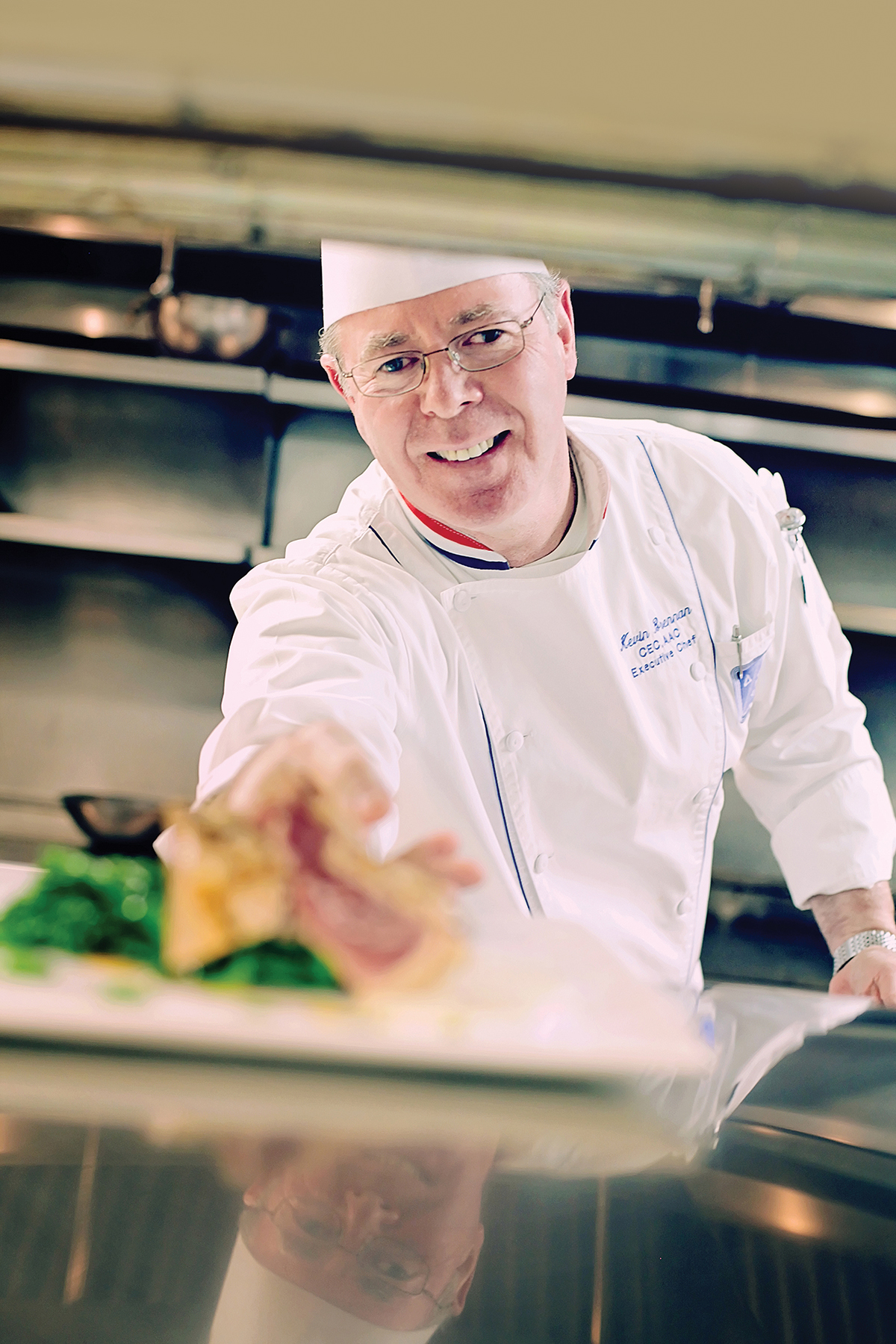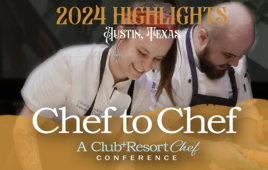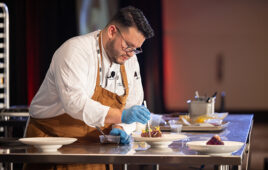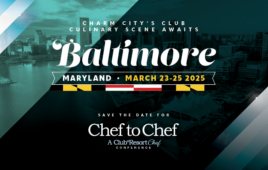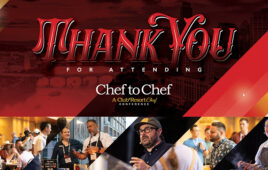
Those who have attended the Chef to Chef
Conference for five or more years were given commemorative pins and then assembled on stage for a group photo, as part of C&RB’s celebration of the event’s 10th anniversary.
Plenty of great ideas and good fellowship filled the air, along with the famous Pike Market fish, as club chefs converged on Seattle for C&RB’s Tenth Annual Chef to Chef Conference.
Club & Resort Business’ Chef to Chef Conference was held March 4-6, 2018 in Seattle, Wash., marking the 10th anniversary of the event that brings together club chefs from around the country (36 states were represented in Seattle, along with three attendees from Canada) for education, networking and the opportunity to experience the local flavor of a noted “food city.”
After an opening reception on the 4th, attendees gathered for a plated dinner that was followed by the keynote address, “So You Are a Club Chef: Bringing ‘Consistent, Disruptive Innovation’ to Your World,” that was presented by Brad Barnes, CMC, CCA, AAC, Director of Consulting and Industry Programs for The Culinary Institute of America in Hyde Park, N.Y.
After reviewing the fast-changing evolution of changing culinary trends throughout the past five decades, Barnes challenged club chefs to make sure they’re ready for the new developments that are likely to come at an even faster pace. These would include culinary trends such as “processed food to fresh food,” Barnes said, as well as societal shifts (“healthcare to health”) and changes affecting chefs’ individual careers and workplace environments (developing an “experience portfolio,” vs. climbing a traditional career ladder; changing the idea of a job to one of entrepreneur; and arranging organizations as social networks, rather than with organizational charts).
Skills required to prepare for what the future brings, Barnes told the audience, will include social intelligence, trans-disciplinary abilities, creating critical and unique insights, having cross-generational cultural empathy, and being able to design “change architecture” and environments that will better support the specific work to be accomplished.
“The future will certainly not resemble the past,” Barnes concluded. “And that means you as chefs must make it a priority to build great teams, create experiences, anticipate the direction of trends, expand your own views and, most of all, know how to sell food the way your members and guests need, expect and want it.”
After the opening dinner concluded, many of the Conference attendees then wrapped up the evening in the popular “Chef to Chef Lounge.” The Conference then reconvened on Monday morning to start the first of two full days of educational sessions.
In Monday’s first presentation, Robert Mancuso, CMC, Executive Chef of the Bohemian Club in San Francisco, joined with Martin Reyes, a Certified Sommelier and Chief Wine Officer for Peter Paul Wines, to address the topic of “Planning and Understanding Food and Wine Pairing Events.”
After walking the chef attendees through the basics of planning and organizing pairing events, the presenters went through the fundamentals of wine styles and character. Mancuso also offered a number of “tips from the CMC” throughout his presentation, which included demonstrations of several dishes and suggestions for how they could be paired. Some of Mancuso’s CMC tips included:
• The food should never be sweeter than the wine!
• Use foods that are naturally acidic.
• Stay away from bitter foods when planning your food and wine pairings.
(More details on Mancuso’s pairing tips and his approach to achieving “one-, two- and three-way” pairings can be found in the April 2018 issue of C&RB’s Chef to Chef magazine.)
Following the Mancuso-Reyes presentation, Brad Barnes returned to address the topic, and demonstrate relevant preparations, of “Taking Plant-Forward Mainstream: Advancing Health and Sustainability.”
Recipes provided by Barnes as part of his demonstration included Tofu Egg Salad, King Oyster “Carnitas” (a play on the original pork for tacos), a Honey Mustard Glaze seasoning, and “Shrimpamole,” a play on guacamole.
Conference attendees were then treated to the entertaining duo of Kevin Brennan, CEC, Executive Chef of the Detroit (Mich.) Athletic Club (DAC), and his Executive Sous Chef, Stephen Swasey, CEC. The two chefs combined to recount, with plenty of witty give-and-take, the details of how a DAC culinary team led by Brennan traveled to New York after receiving an invitation to prepare a dinner at the James Beard House (and of how Swasey stayed behind to make sure things still ran smoothly at the club).
The presentation on “Special Dinner Events: Presenting at the James Beard House—and Sharing the Excitement With Your Club,” walked attendees through how the club’s membership and management supported the effort (including through a special fundraising drive that raised nearly $20,000 towards the cost of the team’s travel and food/equipment expenses), how the team was assembled and how the menu, which featured Michigan specialties, was planned and pre-pared. Insights were also provided into how the honor for the DAC culinary team was used to promote the club’s food-and-beverage excellence.
The DAC chefs were followed by John Garber, Jr., MSHRD, CSP, SPHR, SHRM-SCP, a Managing Director of KMRD Partners, Inc. In his presentation on “The Minefield of Human Resources in the Workplace: Managing Risk Associated with Employment Practices Liability,” Garber advised the attendees that there is increased risk in the workplace because the world has become more litigious, and that supervisors and managers, including chefs, are not immune from liability under discrimination and retaliation claims. That makes it more important than ever, Garber said, to provide a workplace that is based on core values.
Garber then walked the group through specific aspects of training and workplace practices designed to minimize the risks associated with potential exposure to a variety of workplace concerns. These include discrimination charges, violations of the Americans with Disabilities Act, family medical leave, wage and hour pay-related issues such as unauthorized overtime and improper deductions, retaliation, workplace bullying and harassment, which has recently come under much greater scrutiny.
“The employer is strictly liable for the acts of its employees, and for the creation of a work environment that is unpleasant, intolerable or hostile,” Garber said. He advised attendees to take steps in their operations and work with their management to implement preventative measures using policies and procedures drawn from company policy. And when any complaint is received, Garber stressed, the response must involve conducting a timely, thorough and impartial investigation and taking appropriate remedial action, based on the nature of the offense.
Following lunch, Conference attendees reconvened for a panel discussion moderated by Penelope Wong, Executive Chef of Glenmoor Country Club in Cherry Hills Village, Colo., to continue discussion of “burning issues”—including saying “no” to members and whether the benefits of professional certification justify the efforts required to obtain those credentials—that generated a lot of passionate responses after Wong wrote about them in her blog postings for C&RB’s weekly Chef to Chef food-and-beverage e-newsletter.
Wong was joined on the panel by:
• Jason McClain, ACC, Executive Chef of the Jonathon Club in Los Angeles;
• Adam Minicucci, Executive Chef, the Country Club of North Carolina, Pinehurst, N.C.;
• Corey Siegel, CEC, North American Corporate Executive Chef for Electrolux Professional;
• Vincent Horville, Executive Chef, The Metropolitan Club of the City of Washington (D.C.); and
• NgocAnh Nguyen, Sous Chef at Glenmoor Country Club.
The panelists stimulated discussion and questions that were then carried into smaller breakout sessions for the always-popular “Chef to Chef Live” segment of the Conference. At this year’s Conference, the number of breakout sessions was doubled, to six, to ensure smaller groups and effective dialogue and interchange.
Jerry Schreck, Executive Chef of Merion Golf Club in Ardmore, Pa., who once again served as National Conference Coordinator, led one of the “Chef to Chef Live” breakout sessions and others were moderated by leading club chefs from around the country. Topics that were discussed included Staffing and Building a Culinary Brigade; Leadership; Food Costs and the Cost vs. Satisfaction Dilemma; Banquet and Catering Challenges; and Dealing with Dietary Restrictions and Food Allergies.
All attendees then gathered for Monday night’s reception, during which the highly anticipated Mystery Basket competition took place. Participants in the especially spirited action in Seattle included Thomas Mitchell of Kenwood Golf & Country Club, Bethesda, Md.; James Haberstroh of Glen Ridge (N.J.) Country Club; Brandon Gross of The Metropolitan Club of the City of Washington (D.C.); and Brittany Gambrell of Quail Hollow Club, Charlotte, N.C.
As a new aspect to the Mystery Basket competition this year, each dish was judged by a select team of taste testers that included Schreck, Marshall Violante, Executive Chef of the Saddle and Cycle Club of Chicago, and Eric Floyd, Executive Chef of the Washington Athletic Club in Seattle and this year’s Local Conference Coordinator.
Gross and Gambrell squared off in the final round and Gross emerged as the winner, earning a Vitamix blender. For finishing as the runner-up, Gambrell earned a $200 certificate that can be used toward registration at a future Chef to Chef Conference.
(For more details on the Mystery Basket competition and descriptions and photos of Gross’ winning dishes, see the April 2018 issue of C&RB’s Chef to Chef magazine.)
After the Mystery Basket competition and Monday-night reception concluded, attendees had the evening free to explore the local culinary scene, with many following “inside” restaurant recommendations provided by Floyd for the Seattle Dining Guide that was included in attendees’ Conference binders. (Registrants this year also received sharp-looking blue Chef to Chef aprons that proved to be so immediately popular, they were worn by some presenters on stage—see the photo of Micheal Armes).
To begin the final day of presentations, one of the most popular presenters over the Conference’s 10-year history, Vincent Horville, Executive Chef of The Metropolitan Club of the City of Washington (D.C.), returned for his fourth Chef to Chef demo/presentation with an all-new installment of his “New Spins on Old Classics” theme. Horville put Gross, his Executive Sous Chef and the Mystery Basket winner, right back to work to help him wow the crowd with descriptions of creations that ranged from ham and lamb prosciutto and “Italian rope” produced by The Metropolitan Club’s charcuterie program, to pickled eggs and preserved lemon.
Attendees then heard a presentation on two club chefs’ experiences with kitchen renovations. First, Russell Rosenberg, Executive Chef of The Union League Club in New York City, provided details on an overhaul of a main kitchen that had been relatively untouched since 1931. The project, in its first phase alone, involved creating separate a la carte and banquet plating areas; moving a server/coffee station out of the center of the kitchen and to the rear, where it would be closer to the dining room; creating separate mise en place storage areas; and installing walk-in refrigerators and freezers to accommodate jack stacks and rolling racks. The project also involved major mechanical upgrades, including relocation of a condensing unit and conversion of the cooling system from domestic water to air-cooled.
The second part of the kitchen renovation session was presented by J. Kelly Morrow, Executive Chef of Tavistock Country Club in Haddonfield, N.J. Morrow described how the club’s old kitchen was sorely in need of an update, both in terms of structure and equipment, with a layout that did not properly utilize space for chefs and servers to perform efficiently. The existing layout created a bottleneck in the server pickup area, as it also acted as an entrance to the dishwasher area and break room. Additional issues that needed to be addressed included inadequate lighting, out-of-date utilities that were leading to higher costs and power drains, and an exhaust system that needed to be updated to improve air quality.
The solutions, Morrow reported, came in the form of a new kitchen where the hot side is now adjacent to the cold side, opening up the server area and creating more space for a separate plating and prep area. A permanent plating area that doubles as a work station was added, and an updated ventilation system was installed that improved air quality not just in the kitchen, but through the entire clubhouse. Other infrastructure upgrades, to the mechanical, electrical and plumbing systems, yielded energy savings and reduced utility costs.
The Conference then featured a pastry demonstration by Elena Clement, formerly the Executive Pastry Chef of the Chevy Chase (Md.) Club, who now fulfills that role for The Guiding Knife, a Bowie, Md.-based business that provides on-location baking, pastry and culinary training. As part of her session on “Modern Dessert Presentation for the Plate and Buffet,” Clement demonstrated and provided recipes for Chocolate Cremeux, Nut Streusel and Fluid Gel, and showed the audience some creative techniques for creating garnishes and unique plate presentations.
The final session before lunch on Tuesday was presented by Greg Volle, Executive Chef of the Country Club of Roswell (Ga.). Promoting beer pairings as an equally strong opportunity for clubs as wine, Volle showed attendees how to incorporate the vast array of microbrew flavors that continue to proliferate into interesting dishes such as “Drunken Lamb on Barley & Hops,” beer cheese and cauliflower soup, and beer-braised short rib tacos.
After lunch, the Conference reconvened for a presentation by Micheal Armes, Executive Chef of Hound Ears Club in Boone, N.C., on “Expanding F&B Throughout and Beyond the Property: Making the Most of Venues Outside the Clubhouse.” Armes described how he combines the beautiful natural surroundings of the Hound Ears property with his own interest in foraging to provide unique food for events that use the premises in new ways, such as “Starlight Sushi,” food truck street fairs, outdoor chef’s tables, and other “out of the box” events built around themes like “primitive chic.”
Armes was followed by Joey Abitabilo, Executive Chef of Shelter Harbor Golf Club in Charleston, R.I., who addressed “Special Issues for Smaller Clubs” and suggested ways that the challenges that come with smaller operations can be converted to advantages that include the ability to change more quickly and to have more of a hands-on approach to all aspects of a food-and-beverage operation.
Assisted by his son, Isaac, Abitabilo then demonstrated a “de-shelled lobster stew,” employing the Thomas Keller lobster technique, provided a dough recipe for housemade pasta, and displayed techniques for poaching eggs in an immersion circulator and making sushi rice.
The Seattle Conference’s final session featured Eric Floyd’s insider insights on Pacific Northwest cuisine. Floyd highlighted the opportunities presented by the region’s position as a “chef’s paradise” that offers excellent access to fresh seafood and game, fruits, mushrooms, and a strong and growing lineup of local wines and craft beers. Floyd demonstrated how to prepare geoduck, spot prawns and Northwest Dungeness Crab Cakes, and also touted the use of a special grill to enhance both cooking and presentation when used as part of a buffet action station.
The Conference then ended with the announcement that for the first time in Chef to Chef‘s 10-year history, the event would return to a city that has previously hosted it. No one complained, and many cheered, when it was revealed that New Orleans would be the first location to welcome back the Conference; it will be held there March 10-12, 2019.
See Conference materials, including PowerPoint presentations, recipes and supplemental materials, here.
Additional photos can be found here.



